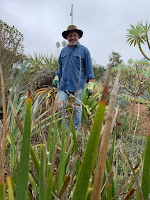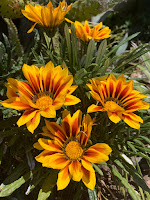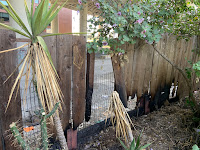Latin name: Leucophyta brownii ("loo-ko-FYE-tah BROW-nee-eye")
Common name: Cushion Bush, Silver Bush
Originally from: Australia
Blooms: Pale yellow pom poms dot the plant in spring and summer
Light: Full sun to light shade.
Water: Winter rain is enough.
Height x width: about 2' x 2'
Zones: 10-12
Where to find in P. Garden: Up along the top border and also in the brights bed
This is a great little silvery pom-pom of a shrublet with really interesting wiry branching stems, a round shape and tiny, close held leaves that make the whole thing look like a tumbleweed. They grow neatly and are more about the foliage than the flowers, but the flowers are cute little 1/2" pale yellow buttons in spring and summer.
We never water them, and in fact they dislike soggy conditions and don't care for heavy soil, preferring poor and well-draining soil so they are perfect for us. It withstands winds and salt spray, so it's perfect for coastal gardens, and can take a light pruning to keep it tidy if needed.
Not long lived, apparently it propagates easily by
seed or semi-hardened stem cuttings, but I've found that Flowercraft often sells inexpensive 6 packs of plug sized (about 2") plants and they grow quickly so I haven't tried propagating them yet.
Occurring naturally on
coastal dunes and cliffs along the south coast of
Australia’s mainland and on the northern coasts of Tasmania, King
Island, and Flinders Islands the more compact form that is in
cultivation was a selection made from near Cape Le Grand in Western
Australia.
As is common in the plant world, this one had a name change along the way, so you might see it referred to by both names. The plant has long been referred to as
Calocephalus brownii
but the genus Calocephalus was found to be "an unnatural group" (whatever that means) and
this plant was segregated into the monotypic genus Leucophyta.
This
previous name for the genus, Calocephalus comes from the Greek words
'calos' meaning "beautiful' and 'cephale' meaning "head" because of the silver rounded heads of flowers. The etymology of the newer
name is from the Greek words 'leuco', meaning gray-white and 'phyta'
meaning plant so combined as "white plant", which is also appropriate.
The species name honors Robert
Brown the Scottish botanist and surgeon who botanized and collected nearly 5,000 plants in Australia on the voyage of the Investigator from 1801
until 1805.
Cushion bush, also
known as silver bush (Calocephalus brownii syn. Leucophyta brownii) is a
very tough and attractive perennial, native to the southern coast of
Australia and nearby islands. It’s very popular in pots, borders, and
larger clumps in the garden, most notably because of its striking silver
to white color. Keep reading to learn more about how to grow a cushion
bush and cushion bush growing conditions.
Cushion Bush Information
Cushion bush does produce small yellow flowers on the tips of its stems,
but most gardeners grow the plant for its foliage. The stems grow thick
and outward in a shape very much like a tumbleweed, and the soft leaves
stay close to the stems.
Read more at Gardening Know How: Cushion Bush Information: Tips On Cushion Bush Care In The Garden
https://www.gardeningknowhow.com/ornamental/shrubs/cushion-bush/cushion-bush-information.htm

















































